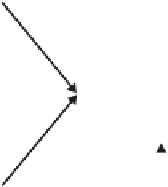Information Technology Reference
In-Depth Information
Figure 8.4
Extended Model of Cognitive Fit
Internal
Problem
Representation
Mental
Representation
for Problem
Solving
Problem-
Solving
Performance
External
Problem
Representation
Problem-Solving
Task
representation for task solution, hence overcoming the confounding of the internal representation of
the problem with the mental representation for task solution in the prior model.
Extending the Theory of Cognitive Fit to Dual-Task Problem Solving
More recently, the theory of cognitive fit has been used in problem-solving situations involving
dual tasks.
Many IS tasks can be viewed as involving dual tasks. We can conceive of this in two, related
ways. First, all IS problem solving involves both the domain of IS and the domain of the applica-
tion to which it is being applied. IS domain knowledge consists of representations, methods, tech-
niques, and tools that form the basis for the development of application systems. Those
application systems are developed to organize/structure solutions to real-world problems that
exist in a given business area, or application domain; they could be in accounting, sales, or mar-
keting, for example. It is clear, then, that knowledge of the IS and application domains go hand-
in-hand in solving problems in IS. Second, many IS tasks themselves are, in fact, comprised of
two types of tasks. For example, software comprehension is known to play a key role in debug-
ging and in making changes to software (Hendrix et al., 2002; Robson et al., 1991). Note that,
here, software comprehension is heavily based on application domain knowledge (see Shaft and
Vessey, 1995); hence, in this instance, comprehension is synonymous with knowledge of the
application domain.
Problem solving in these types of tasks can be conceptualized as the relationship between the
two interacting sub-tasks. Figure 8.5 presents a general conceptualization of dual-task problem
solving that views IS problem solving as involving both the domain of information systems and
that of the application.
2
The relationship between the dual tasks appears to be moderated by the type of task under
investigation. The task characteristic that appears to influence problem solving is the extent to
which the task solution is well understood, and therefore can be structured. (See Reitman's [1964]
original conceptualization of tasks as being either well or ill structured in nature). When the task
is ill structured, as in modifying computer software, both tasks are essential to effective problem










Search WWH ::

Custom Search